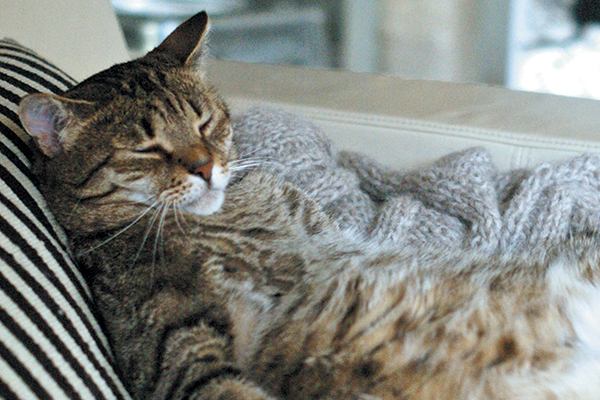Have you ever wondered if your cat is too fat? We’ve all heard it before. An overweight and obese cat is less healthy than a lean cat. Cats who carry around too much weight are less active and have less energy, and they’re at higher risk for certain diseases and conditions.
First, how can you tell if your cat is obese?

If your cat’s body weight is 20 percent or more than her ideal “normal” weight, she is considered obese. But how can you know if your cat is truly obese or just a big cat? It can be hard to tell, especially if your cat is very fluffy. Also, because so many pets are heavier than they should be, we’ve gotten used to seeing fat cats and thinking that they’re just normal-sized cats. In fact, nearly 60 percent of all cats in the United States are overweight or obese, according to the Association for Pet Obesity Prevention.
When in doubt, ask your veterinarian if your cat is overweight during her annual exam. Since your vet weighs your cat at every visit, it’s easy to look back in her records to see if she has gained weight over the years. Your vet can also do what is called body condition scoring to determine if she is overweight.
Can you tell if your cat is obese at home?
If you’re curious, evaluate your cat’s weight at home by following some simple guidelines. “Place your hands on either side of the cat,” says Stephanie Demarco, DVM, of VCA Kirkwood Animal Hospital in Newark, Delaware. “If it’s difficult to feel the ribs, it’s likely that the cat is overweight. Also look at the cat’s waist — he should have one. If it is just as wide from the chest through the waist, [your cat is] probably overweight.”
Some other hints that your cat might be piling on too many pounds: if you need to loosen her collar (or if you need to buy her a bigger collar), if she starts slowing down or not walking around or playing as much as she used to, if she stops climbing the stairs, or if she seems short of breath, sleeps more or seems grumpier than she used to be.
Remember — your vet is always your best bet for diagnosing an obese cat
With the variations that exist among all cats, the number of pounds are not always the best indicator of whether a particular cat is fat or not, but your vet can help out with this part.
“We now have tools that factor in a cat’s age, breed and overall body size to see if they truly are overweight and what their ideal weight should be,” Dr. Demarco explains.
What are obese cats at risk for?
“They are at higher risk for heart disease, diabetes mellitus, osteoarthritis, kidney disease and liver disease, to name just a few,” Dr. Demarco says. “Studies have proven that even if they don’t develop one of these diseases, they just have a shorter life span in general than cats who are not overweight.”
What can you do about an obese cat?
If you or your vet determine that your cat is in need of a slim down, there are a number of ways to help her shed those pounds. Diet is the first consideration. Although you will find plenty of “light” diets at the pet-supply store, the answer is not always as simple as switching to a diet food. Additionally, knowing how much to feed your cat varies considerably depending on the type of food you’re feeding. The suggested amounts on the label are usually more than the average cat needs and much more than an overweight or obese cat needs.
“Visit your veterinarian and set up a plan,” Dr. Demarco says. “Foods have different ingredients with different caloric densities, and some cats have other medical issues that need to be considered, so this all goes into the plan. Work together to pick the best diet for your pet and determine how much of a specific diet you should feed.”
What and how to feed obese cats

If you feed dry food, your vet might recommend making a switch to canned food, which provides more protein and fewer carbs than kibbled diets, and may help your cat feel full longer. Canned food also provides extra fluid, something that is beneficial because cats tend not to drink as much water as they should.
Feeding scheduled meals, rather than free feeding or leaving food out at all times, is something that benefits all cats, not just overweight cats. Free feeding is convenient for us humans, but cats tend to snack all day and consume more calories than they need. They might also eat out of boredom when food is always available. Feeding scheduled meals also allows you to serve measured portions so you know your cat isn’t consuming too many calories.
Exercise for an obese cat
“Weight loss alone often isn’t enough,” Dr. Demarco says. “Increasing exercise, although challenging in some cats, can be very rewarding. Cats tend to have short attention spans, so activities usually don’t last more than a few minutes. Rotating through different toys that stimulate multiple senses and the predatory drive of cats can be very beneficial. As little as 15 to 20 minutes per day can help with weight loss.”
Need your own excuse to get moving? Sitting disease is a thing — and you can avoid it >>
While your cat is on a weight-loss program, your vet will want to see her regularly for weigh-ins. “Regular checkups are very important to make sure that any problems they are encountering can be discussed and, if the plan isn’t working, what you need to do to make it work,” Dr. Demarco advises.
Thumbnail: Photography ©sae1010 | Thinkstock.
Looking for a definition of human obesity? Check this article out >>
Read more about handling overweight cats on Catster.com:








